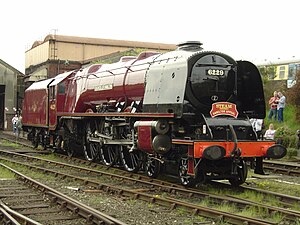| LMS Coronation Class | |||||||||||||||||||||||||||||||||||||||||||||||||||||||||||||||||||||||||||||||
|---|---|---|---|---|---|---|---|---|---|---|---|---|---|---|---|---|---|---|---|---|---|---|---|---|---|---|---|---|---|---|---|---|---|---|---|---|---|---|---|---|---|---|---|---|---|---|---|---|---|---|---|---|---|---|---|---|---|---|---|---|---|---|---|---|---|---|---|---|---|---|---|---|---|---|---|---|---|---|---|
 No. 6229 Duchess of Hamilton | |||||||||||||||||||||||||||||||||||||||||||||||||||||||||||||||||||||||||||||||
| |||||||||||||||||||||||||||||||||||||||||||||||||||||||||||||||||||||||||||||||
| |||||||||||||||||||||||||||||||||||||||||||||||||||||||||||||||||||||||||||||||
| |||||||||||||||||||||||||||||||||||||||||||||||||||||||||||||||||||||||||||||||
| |||||||||||||||||||||||||||||||||||||||||||||||||||||||||||||||||||||||||||||||
The London, Midland and Scottish Railway (LMS) Coronation Class[a] is a class of express passenger steam locomotives designed by William Stanier. They were an enlarged and improved version of his previous design, the LMS Princess Royal Class, and on test were some of the most powerful steam locomotives ever used in Britain at 2,511 dbhp.[1]: 86–87 The locomotives were specifically designed for power as it was intended to use them on express services between London Euston and Glasgow Central; their duties were to include the hauling of a proposed non-stop express, subsequently named the Coronation Scot.
The first ten locomotives of the Coronation class were built in a streamlined form in 1937 by the addition of a steel streamlined casing. Five of these ten were specifically set aside to pull the Coronation Scot. Although a later batch of five unstreamlined locomotives was produced in 1938, most of the ensuing Coronation class were outshopped as streamliners. From 1944 until production ended in 1948, all-new engines were built in unstreamlined form and all the streamliners had their casings removed. The last of the 38 locomotives was completed in 1948.
The Coronation class was probably painted in more styles of livery than any other engine class; seven in the LMS era up to 1947 and five more during the British Railways era from 1948 onwards. That does not mean that all 38 locomotives were painted in all these different styles; many were specific to just a few engines. The only style that all 38 bore was the British Railways lined Locomotive Green and the entire class was turned out thus between 1955 and 1958.
It was customary on all British mainline journeys to change engines at convenient locations to avoid the lengthy process of re-coaling. The Coronation locomotives were therefore strategically stationed at key points between London and Glasgow and they would be assigned to the shed at that location. The chosen locations were at London (Camden shed), Crewe (Crewe North), Carlisle (Upperby) and Glasgow (Polmadie). It was only in the latter days of steam that the mix of shed assignments became more fluid.
No. 6220 Coronation held the British steam speed record between 1937 and 1938, 114 miles per hour (183 km/h).[2][3] It held that record until beaten by 4468 Mallard in 1938. Secondly, No. 6234 Duchess of Abercorn holds the record to this day for the greatest British power output to be officially recorded on an attached dynamometer car, achieved in 1939.[4] The Coronation class was represented at the 1948 British Railways locomotive exchange trials, designed to compare the performances of similar locomotives from the four pre-nationalised companies, but they performed extremely poorly. After this, they were targeted for low coal consumption instead of extreme pulling power [clarification needed]. One of the class was involved in the Harrow and Wealdstone rail crash precipitated by 46242 City of Glasgow. This was the second worst rail crash in British history, the death toll being 112.[5]
After a successful decade of operations in the 1950s, the 1955 Modernisation Plan's increased use of diesel locomotives made many of the class redundant, and the electrification of the main line between London Euston and Crewe resulted in their removal from this important section of the main line as there was insufficient clearance between the locomotives and the overhead wires. With no suitable work available, the survivors were scrapped from late 1962 to late 1964. Three locomotives were saved for preservation, with one of them ending up in the National Collection. As at October 2016, two are static in museums whilst the third is certified for main line service.
Cite error: There are <ref group=lower-alpha> tags or {{efn}} templates on this page, but the references will not show without a {{reflist|group=lower-alpha}} template or {{notelist}} template (see the help page).
- ^ Nock, O.S. (1984). British Locomotives of the 20th Century, Volume 2 1930-1960. Cambridge: Patrick Stephens. ISBN 0-85059-596-7.
- ^ Doherty, Douglas (1 January 1973). The LMS Duchesses. Model and Allied Publications. ISBN 085242325X.
- ^ Nock, Oswald (3 November 1972). Speed Records on Britain's Railways: A Chronicle of the Steam Era. New York City, NY: Macmillan. ISBN 0330233653.
- ^ Roden, Andrew (17 September 2015). The Duchesses: The Story of Britain's Ultimate Steam Locomotives. Aurum Press Limited.
- ^ Hub, The Railway (28 February 2020). "LMS Coronation Class: Britain's most powerful locomotives? - The Railway Hub". Retrieved 14 August 2021.